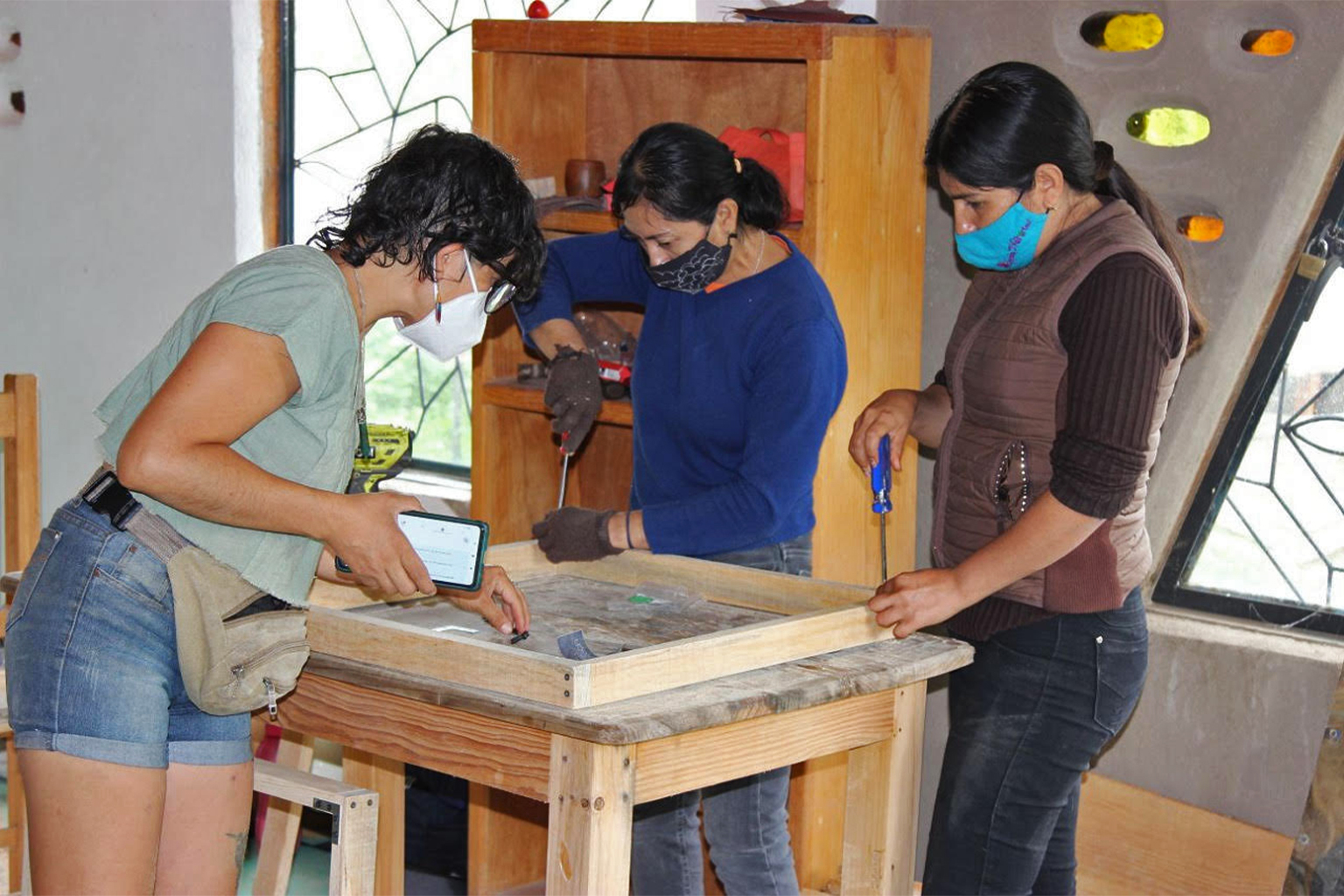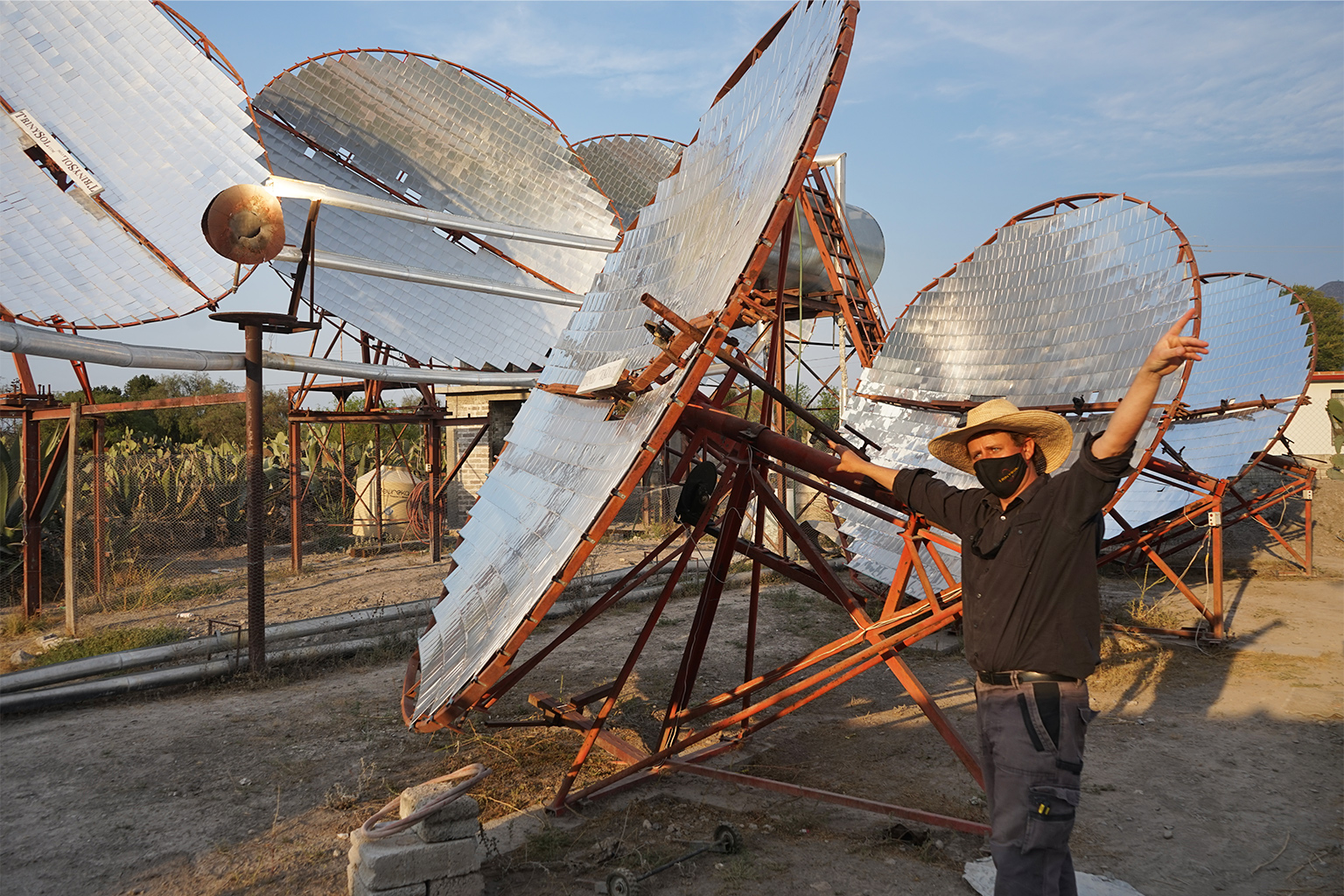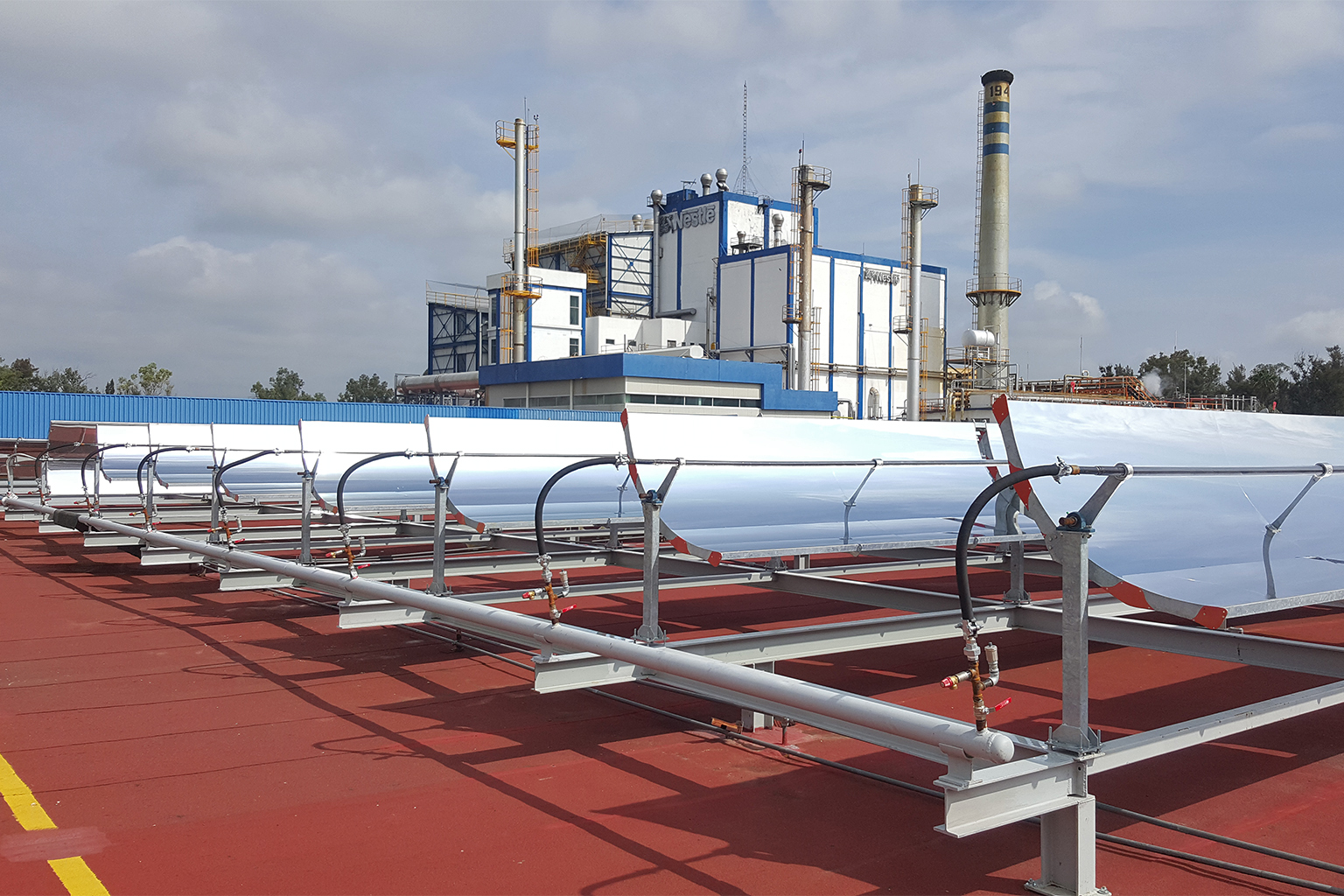Cooking with the sun: Entrepreneurs help launch Mexico’s solar revolution
Oct 27, 2021
- Much of Mexico gets 300 days of sunshine out of the year which is helping make the country a solar energy pioneer. With the current government showing little interest in the clean sustainable technology, a range of entrepreneurs is leading the way, especially in the food industry.
- In the southern state of Oaxaca, Victoria Aguilera studied sustainable energy at the regional university and founded Sazón del Sol, a grassroots project that includes a solar farm, solar restaurant, and solar food processing workplace. She designed and now sells a solar kitchen for use in homes and restaurants.
- In central Mexico’s Hidalgo state, Gregor Schäpers’ company, Trinysol, achieved initial success with solar-powered water heaters. Now he’s experimenting with solar cooking using Scheffler modules — solar dish reflectors to run kitchens in restaurants, hotels, mezcal distilleries and tortilla bakeries.
- In the state of Jalisco, Angel Mejía and Aldo Agraz co-founded Inventive Power in 2010, specializing in thermal solar systems. Local food factories and dairies were their first clients. Since then, Mexican and international companies Nestlé, Barcel, Unilever, and tequila producer José Cuervo have all commissioned projects.
OAXACA and HIDALGO states, Mexico — Victoria Aguilera, Gregor Schäpers and Angel Mejía all live in different regions of Mexico and they’ve never met each other. But all three have the same goal: to convince their fellow Mexicans — and the world — of the extraordinary benefits of solar energy, and especially solar cookery.
Mexico enjoys an average of 300 days of sunshine every year — an enormous energy potential, only a fraction of which is used. When it is employed, it is usually as photovoltaic power generation or to heat water in single-family homes, both approaches now encouraged via tax incentives or cheap loans.
But when it comes to cooking or food preparation processes, such as distillation, drying or pasteurization, the first choices of Mexican businesses continue to be fossil fuels — gas and diesel — and sometimes wood, all of which contribute to global warming and are harmful to health.
Mexico’s entrepreneurs hope to change that.

Cooking with the sun instead of smoking logs
In the southern state of Oaxaca, an Indigenous region and one of the poorest in Mexico, a lot of cooking is still done with wood. For generations, women have prepared beans and corn tortillas over open fires.
The characteristic cooking smell — acrid wood smoke, mixed with the odor of roasting sweet maize — lofts daily over Santa María Yacochi, a remote mountain village. In one house, the women of the Martínez family, from the Mixes ethnic group, prepare meals on flickering flames that create a cozy kitchen illusion. In fact, that wood fire isn’t at all healthy. The kitchen walls and pots are black from soot. The women, who spend most of their time in the kitchen, suffer from respiratory and lung diseases. Collecting wood is a backbreaking job, done by children and older people.
NGOs have introduced improved stoves in some houses, and though they are less smoky and need less wood, Victoria Aguilera was never satisfied with this solution. The 37-year-old from Oaxaca studied sustainable energy at the regional university, and 10 years ago joined forces with like-minded people to popularize solar kitchens in Oaxaca. She designed prototype kitchen equipment herself.
Then, in 2014, she founded Sazón del Sol, a grassroots project that today includes a solar farm, solar restaurant, and a solar food processing workplace with an attached shop.
Today, Sazón del Sol (Spanish for “Seasoning of the Sun”) offers three solar units: a solar hot plate consisting of a prism-shaped reflector with a solar cooking pot costing roughly $175; a wooden box lined with aluminum and two glass reflectors with enough room for three pots or a baking tray, costing $275; and a slightly cheaper wooden table with a transparent plastic cover for drying fruit and vegetables.


Changing habits is a big challenge
“We first took the cookers to the slums and to eco-markets in the city center to spread the word,” Aguilera remembers. Many visitors were curious, but few bought a solar stove or came to a solar cooking workshop to learn how to use one.
For university professor and energy expert Ricardo Pérez Enciso, this lack of interest isn’t surprising. “The technical problems of solar energy are easier to solve than changing the habits of the population,” he explains.
Pérez Enciso knows what he’s talking about. He is a solar specialist and head of the Department of Industrial Engineering at Sonora University (Unison). Overcoming ingrained habits isn’t the only hurdle, he explains. Solar kitchens suffer from other limitations. They require direct sunlight to operate, cooking takes longer, they only have a life span of about 10 years, and people must be taught to use them. Importantly, at night or when it‘s raining, solar kitchens are out of action.
This nighttime problem has proved to be a major drawback for families from Oaxaca and towns like Santa María Yacochi, where women cook their husbands’ food before dawn, ahead of the day’s work in the fields.
But Aguilera never gave up. Instead, she did solar catering for various NGO events, demonstrated her solar stoves in schools, and offered workshops in poorer neighborhoods that included the purchase of a solar oven in the course fee.
Slowly, solar cooking spread throughout Oaxaca. A particular catalyst was the introduction of a solar-powered taco stand at a weekly market in the state capital, Oaxaca de Juárez. This novelty attracted many young people, who immediately saw solar cooking as a business opportunity.

A holistic concept whose time has come
Aguilera is not only concerned with saving energy and protecting the climate. “We are also focused on holistic development and improving the quality of life.” Solar cookery is aimed at changing eating and consumption habits as well, she explains.
The popularity of fatty and sweetened foods throughout Mexico means the country has a serious problem with obesity and diabetes. So Aguilera set up diet plans in her cooking classes and restaurant, and introduced a variety of tasty, healthy vegetarian foods, featuring almost-forgotten local ingredients such as edible flowers.
Basic ingredients come from nearby farms, with the goal of bringing producers and consumers closer together. These interconnections improve farmers’ incomes as well as enable poorer families to eat more varied, inexpensive, local, organic food. Through solar processing, such as fermentation or drying, these nutritious, healthy foods can be preserved without refrigeration and be available throughout the year. Another positive outcome: families are less dependent on grocery stores and spend less money on processed food.
The Sazón del Sol project now has four employees. Around 500 people have taken part in the workshops, and many of them now act as ambassadors for solar cookery, serving as role models in their communities.
“During the pandemic, interest in healthy nutrition and producing one’s own food has increased significantly,” says Aguilera. The future now looks bright for solar cooking.


Scaling up solar energy in the food and cosmetics industry
Even in a country as sunny as Mexico, there are various climates, resulting in solar limitations. “Not every area, nor every industry, is equally suited to solar energy,” explains Pérez Enciso. Solar panels are, for example, more efficient in the desert-like north of Mexico than in the subtropical, rainy south.
Solar energy is also unsuitable for industrial processes that require extremely high temperatures, such as the steel or cement industries. However, for the food and cosmetics industries, solar use is predestined, says Pérez Enciso. Temperatures up to 150° Celsius (302° Fahrenheit) are ideal for food prep processes that include pasteurization, drying, distillation, and the production of emulsions.
“The [food and cosmetics] sectors together consume 60% of the industrial demand for process heat in Mexico,” Pérez Enciso calculates. But, he adds, as of today, the large-scale conversion of industrial applications to solar remains a big technological step, of which Aguilera’s home solar ovens are incapable.
This is the gap that Gregor Schäpers hopes to close. The 44-year-old lives in Cardonal, a farming town in the middle of a cactus desert in central Mexico’s Hidalgo state. He owns Trinysol, a startup that has set itself the goal of converting this marginalized area into a thriving solar economy. Schäpers achieved initial success with solar-powered water heaters, which today are perched atop numerous private homes and hotels in the area.
“But the Chinese now produce them cheaper,” he explains. That’s why he took the next step forward, experimenting with solar cooking aimed at local restaurants, hotels and medium-sized businesses such as mezcal distilleries and tortilla bakeries.
Schäpers is convinced that solar cooking and distilling, as used by business, can help Mexico — and other parts of the world — leave the fossil fuel era behind. “Solar is very versatile, clean and reduces the need for firewood, thus protects forests. It is climate-friendly, saves money and strengthens small and medium-sized businesses in the region,” he concludes.
See related: Keeling Curve Prize awarded to solar cooking and other climate change-reducing projects


Baking and distilling with reflectors
Schäpers’ solar company uses extremely efficient Scheffler modules — large, round reflectors that concentrate sunlight at one point and look a bit like satellite dishes. He makes the reflectors in his own factory, where he employs 10 workers.
To convince business owners of the power and promise of solar cooking technology, Schäpers set up six reflectors on his property in Cardonal. Also, in Trinysol’s showroom, Schäpers regularly bakes solar cakes and boils down agave syrup with solar-heated steam.
“I do this to demonstrate to potential customers that it works!” he smiles.
Scheffler reflectors can be used in two ways: For kitchens or bakeries, they concentrate sunlight on an iron core embedded directly in a building wall, which then heats a cooker or oven. In the second method, solar reflectors heat water in tanks until steam is produced. This steam flows through a pipe into a mini distillery in Schäper’s demonstration workshop. Both techniques have multiple industrial applications.
There are a few obstacles: Since the sun moves during the day, the reflectors have to be adjusted often. Schäpers currently does this by hand. For customers, however, he needs automated tracking sensors that can follow the sun and maximize the concentration of solar energy throughout the day. In addition, Scheffler reflectors need a lot of space, which smaller urban businesses don’t always have.

Rising gas and petrol prices increase demand
Although Schäpers has yet to begin advertising his solar ovens, and only runs a blog and a Facebook page to garner publicity, potential customers are constantly calling.
A sharp rise in prices of natural gas and petrol during recent months — costs expected to increase in the future — is boosting demand. A tortilla bakery in a neighboring village has ordered solar panels, a women’s cooperative is using them to produce agave syrup, and a refugee hostel has expressed interest for its large kitchen. Tequila and mezcal distilleries, which until now have burned environmentally harmful heavy oil, have also approached him.
Angel Mejía has noticed something similar. “In the last two or three years, [solar] interest has increased strongly,” says the engineer from Zapopan in Mexico’s Jalisco state. In 2010, he and business partner Aldo Agraz co-founded Inventive Power, a company specializing in thermal solar systems.
“The first few years were difficult,” Mejía recalls. “We perfected and patented the technology, and at the same time we had to raise capital, build a factory, design a commercially viable product and then win customers for it.”
Unlike Schäpers, the two entrepreneurs work with linear parabolic antennas. These efficient solar collectors look like oversized, movable gutters, set up in rows as is done with photovoltaic panels. The units heat up to 250°C (482°F) and generate steam, which is used to run various industrial processes.
A computerized remote control tracking system that adjusts the panels to track the sun’s position was designed and paid for using government funding provided by the National Council of Science and Technology (Conacyt). But the company still had to struggle to thrive. “It was a lot of door-to-door campaigning!” Mejía recalls.

Money savings wins over transnational companies
In 2012, Inventive Power installed its first four projects. “They were local food factories and dairies from the region whose owners were interested in ecology and technology and were convinced by the savings potential of solar energy,” Mejía says.
A year later, the company won an innovation award from the Inter-American Development Bank, and in 2014 the founders were named Entrepreneurs of the Year by CNN. That distinction brought Inventive Power to the attention of major Mexican and transnational companies, which commissioned projects — including Nestlé, Barcel, Unilever, and tequila producer José Cuervo.
Each project is unique, adapted to a client’s needs and the regional climate. A basic project starts at a cost of around $50,000, but savings potential for clients is enormous, says Mejía. “On average, the investment is amortized in two and a half years.”
The installations have a life span of 20 years and save up to 80% of the money previously spent on fossil fuels, including diesel and liquefied petroleum gas (LPG). “We used to need 20,000 liters [nearly 5,300 gallons] of fuel every six weeks,” says client Gerardo Ramírez from El Angel, a dairy. “Now we only need half as much. The [solar] investment has really paid off and I would recommend it anytime.” One drawback: no business runs on solar alone; backup from fossil fuels is needed for rainy days or for factories that operate around the clock.
Inventive Power now has 40 employees, with 200 projects carried out so far, and an estimated 5,000 metric tons of CO2 saved as a result. Today, Inventive Power is the market leader in thermal solar energy in Mexico.
This is only the beginning, hopes Mejía. “For example, in the auto industry there are still many possibilities for solar projects.”

Thanks to Mexico’s entrepreneurs, the nation has become a pioneer in solar energy, according to Pérez Enciso. “We have a big range of solar technologies for different applications, from the simple and cheap family cooker to the complex industrial plant using solar energy. This diversity is a great strength.”
Still, he would like to see more interest and assistance from the government. However, Mexico President Andrés Manuel López Obrador continues betting on fossil fuel and is endeavoring to make the state-owned oil company, Pemex, profitable again. He has cut spending for universities and scientific research, while keeping the electorate happy with subsidized cooking gas.
“In Chile, in 2019 the government built a huge concentrating solar power plant in less than two years,“ says Pérez Enciso. “Here in Mexico, we have been perfecting solar technology for 15 years and have not yet managed to get the government interested or to provide money for it.” But that hasn’t held back private innovators. For Victoria Aguilera, Gregor Schäpers, Angel Mejía and others, the future looks to be as bright as the sun over Mexico.
Banner image: Gregor Schäpers and his Scheffler solar concentrator in Cardonal, Mexico. Image by Sandra Weiss.
See related coverage: Keeling Curve Prize awarded to solar cooking and other climate change-reducing projects
FEEDBACK: Use this form to send a message to the author of this post. If you want to post a public comment, you can do that at the bottom of the page.